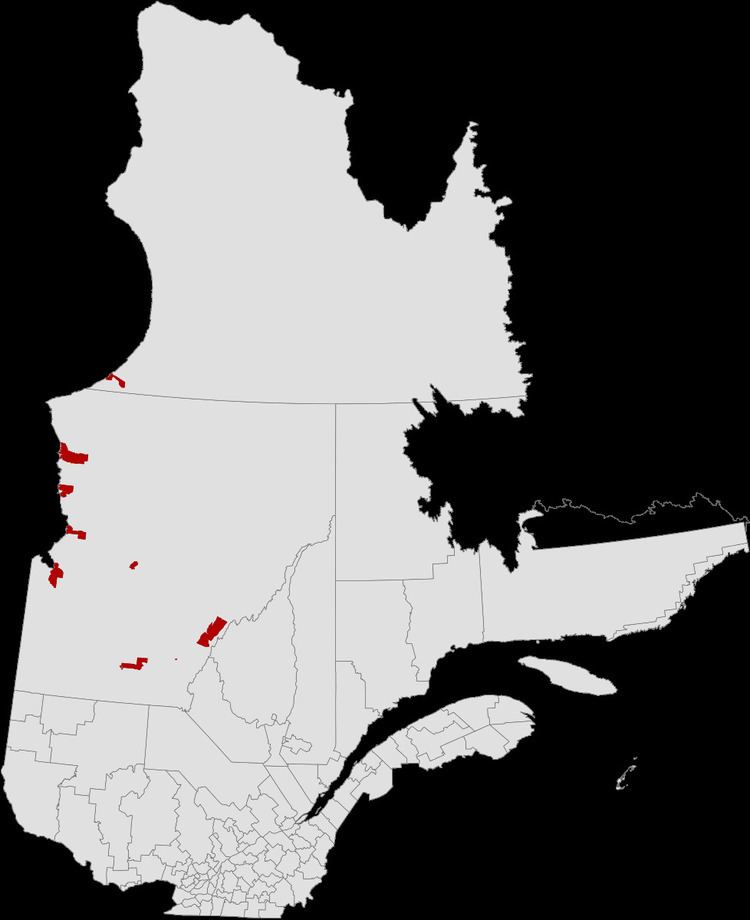 | ||
The Grand Council of the Crees (Eeyou Istchee) or the GCCEI, is the political body that represents the approximately 18,000 Crees or “Eeyou” ("Eenou", Inland dialect) of the territory called Eeyou Istchee ("The People's Land") in the James Bay and Nunavik regions of Northern Quebec, Canada. The Grand Council has twenty members: a Grand Chief and Deputy-Grand Chief elected at large by the Cree people, the Chiefs elected by each of the ten communities, and one other representative from each community.
Contents
- History
- Cree Regional Authority
- Political developments
- Grand Chiefs
- Eeyou communities of the Grand Council
- References
The current Grand Chief Matthew Coon Come was elected in 2009. The current Deputy Grand Chief is Rodney Mark. The Grand Council’s head office is located in the Cree community of Nemaska, with other offices and embassies in Montreal, Ottawa and Quebec City.
History
The Grand Council was formed in 1974 in response to the James Bay Cree hydroelectric conflict, which had already been underway since 1971. When the James Bay Project was first announced, Eeyou Istchee was still governed by a traditional political structure. That political structure was organized to exploit the resources of Eeyou Istchee by their traditional way of life. The land of Eeyou Istchee was divided into smaller territories, each headed by a leader or "ucimâu", that were resource management units and a means of distributing the Eeyou people over a vast territory. So the Crees organized themselves at a council of ECree leaders to represent their rights at the negotiations between the Cree Nation and the Quebec and Canadian governments, which led to the signing of the James Bay and Northern Quebec Agreement in November 1975.
On July 24, 2012, the Quebec government signed an accord with the Eeyou Nation that would result in the abolition of the municipality of Baie-James and the creation of a new regional government Eeyou Istchee/Baie-James Territory.
Cree Regional Authority
The Cree Regional Authority (CRA), formed in 1978, serves as the administrative authority of the Cree Nation of Eeyou Istchee and provides programs and services to its communities. The CRA is responsible for environmental protection and is also the legal body representing the nation to provincial and federal administrations.
While the CRA is a separate legal entity from the GCCEI, they have identical membership, board of directors, governing structures and are de facto managed and operated as one organization by the Cree Nation.
An accord signed between the Cree Nation and the Quebec government on July 24, 2012 calls for the status and name of the Cree Regional Authority to change to the "Cree Nation Government" (Gouvernement de la nation crie). The Cree Nation Government currently has 309 employees.
Political developments
The Grand Council of the Crees has been active in asserting the right of the Cree Nation to determine their own future, in the event that Quebec secedes from Canada. In October 1995, the Grand Council issued a "Message regarding the rights of the Crees and other Aboriginal Peoples of Canada, which stated, in part:
"Now in 1995, although we live in a modern and democratic state, protected by the Canadian Constitution with its Charter of Rights and Freedoms, our people and our territory may once again be transferred from sovereign to sovereign, this time from Canada to what may become the newly independent state of Québec. And although there is now a United Nations, with a Universal Declaration of Human Rights and a vast array of international human rights instruments that should protect us, a process has been set in motion that would forcibly remove the Crees from Canada, and incorporate us and our lands in this new state."
A few days prior to the October 30, 1995 province-wide referendum on secession from Canada, the Grand Council facilitated a referendum within Eeyou Istchee on the question of whether the Crees should be authorized to separate from an independent Quebec, in order to remain part of Canada. Over 96% of participating voters chose to remain in Canada.
Grand Chief Matthew Mukash is considered a traditionalist and fought against the Great Whale hydroelectric project in the 1990s, alongside the Grand Chiefs Matthew Coon Come and Billy Diamond. In 2002, he opposed the signing of the Paix des Braves, a comprehensive 50 year political and economic agreement with the Government of Quebec, and as well as the 2002 and 2004 agreements with Hydro-Québec on the joint development of the hydro-electric resources of the Rupert River.
Elected in late 2005 as Grand Chief, in replacement of Ted Moses, Matthew Mukash is opposed to the Rupert River Diversion which is undergoing joint Quebec-Cree environmental assessment since 2004. Mukash has advocated with the Government of Quebec and Hydro-Québec to pursue wind power as an alternative source of economic development and energy. His other main political goals are to prepare a constitution, build sovereignty, encourage nation-building, and move Cree leadership back to Eeyou Istchee from Montréal and Ottawa.
